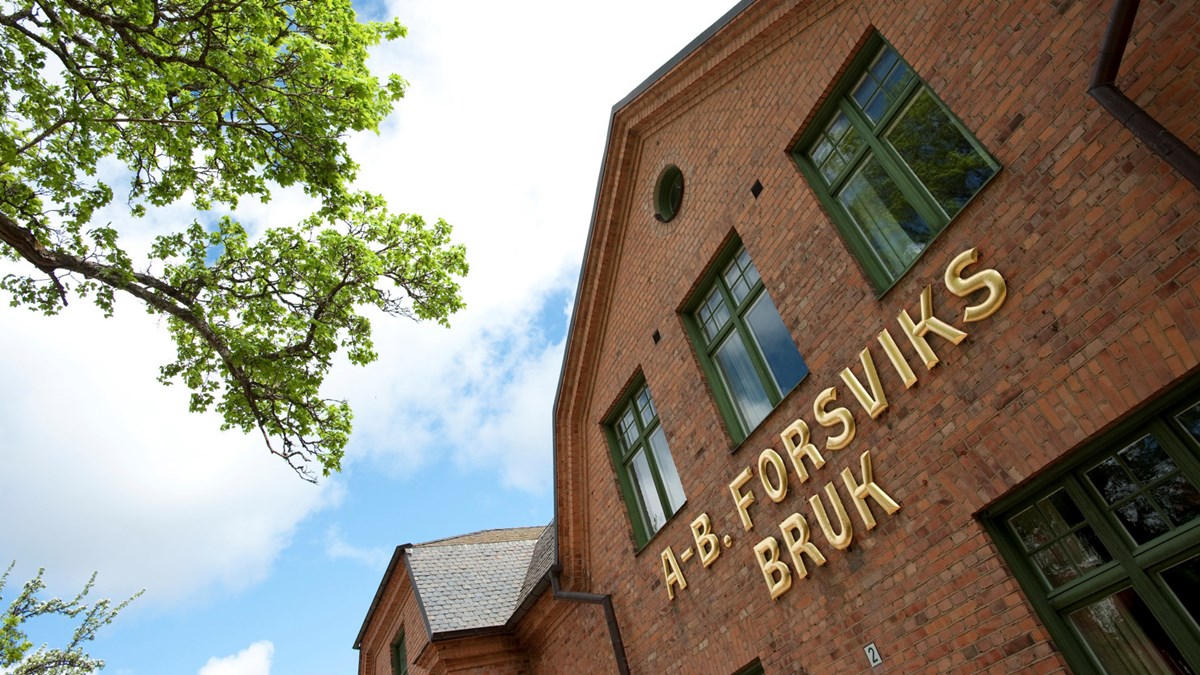Forsviks Bruk - 600 years of industrial history in one place

The Middle Ages
The force behind Forsviks Bruk’s industrial activities comes from the falls where lake Viken flows into Bottensjön and lake Vättern. The site is named after the farm at that place in the middle ages.
Cecilia Jonsdotter Roos donated the Forsvik farm to the convent in Vadstena and when the monastery took it over at the beginning of the 15th century there was already a flour mill on the farm.
In the name of God, Amen. I, Cecilia Jonsdotter, being of sound mind and soul, recognize through this, my open letter, that I have allowed and given to Our Holy Mother and Saint Brigit’s Convent // a mill called Forsvik.
Through the use of dams, the height of the fall in the rapids was increased by two metres. A new flour mill, a sawmill and a hammer mill were built. The water-powered saw in Forsvik is the first known sawmill mentioned in writing.
On the Forsvik farm, boards were cut for the convent building in Vadstena. The convent also set up a hammer mill at an early stage, mentioned in the cadastral books in 1457. When the Reformation came in 1527 and the convent was dissolved, Forsvik was transferred to the Crown’s ownership. The wood that was sawn at Forsvik was then used for the castle in Vadstena, which Gustav Vasa had started to build.
Age of the ironworks
After some difficult years at the end of the 16th century, activities gradually recovered and at the end of the 17th century, the ironworks age started. The lord of the manor Anton von Boij was granted a royal prerogative to construct a rod iron works with two hammers and four forges in Forsvik.
In von Boij’s ironworks empire, with its centre in Tiveden, there were over a dozen blast furnaces and hammers in total. Sweden dominated the export market for iron and Forsvik produced iron bars that were shipped on the sea for onward transport from Mariestad and Gothenburg.
The rod iron age continued until the 1850s when its importance suddenly waned in Sweden, leaving many ironworks under the threat of closure. In 1720 Forsvik was taken over by Sebastian Tham, and remained in the Tham family until 1840. During the entire ironworks epoque, agriculture, milling and sawing were smaller industries.
Industrialisation
Ironworks decreased in importance and a gradual change took place at Forsviks Bruk when the foundry owner Troselius took over in 1840. Twelve years later he died, and his son-in-law Carl Wilhelm Palmaer took over the main farm at Forsvik. Palmaer gave the old works a new direction, opening a foundry (1859), a mechanical workshop (1861), a wood pulp mill (1870) and shortly thereafter a steam-powered saw (1878). Water as a source of power was taken out of service.
The production of iron bars finished in 1869 and in the same year the works were transformed into a limited company. Its earliest products were farm machinery, followed by pumps, valves, pipes, fire hydrants, engines, wood pulp machines and castings of various kinds.
The manufacture of wood pulp started on a large scale in Sweden at the end of the 1860s and in 1871 Forsvik started its own mill for the manufacture of wood pulp. It had a new patented process that gained a great deal of attention. A hot air oven (“calorifier”) was built for the wood pulp mill in 1876 to dry the paper mass, and is currently the only
surviving one of its type in Sweden. There was also a shipyard at the works in the 1930s, where ships were built and repaired.
The sawing and agricultural sections were separated from the works in 1932. The wood pulp mill was laid down in 1940 and the flour mill in 1961. The foundry and the mechanical workshop were closed in 1977 in connection with the shipbuilding crisis in Sweden, and the sawmill (AB Forsviks Skogar) was closed as late as spring 1999.
The present
The restoration of the abandoned works was started in the beginning of the 1980s. It initially focused on the buildings’ exteriors but was later developed to include the interiors of the buildings and a permanent exhibition about industry in Forsvik was set up at the beginning of the 1990s. The Interest Association of Old Forsvik organised showings in the mill and the smithy as well as guided tours.
A few years later (1993) an antiquarian was hired to lead work on site at Forsvik, with continued renovation and development of activities there. The threatened works, with demolition orders on several buildings, was gradually transformed into a living industrial museum with showings, exhibitions, guided tours, courses and education programmes, music and theatre.






